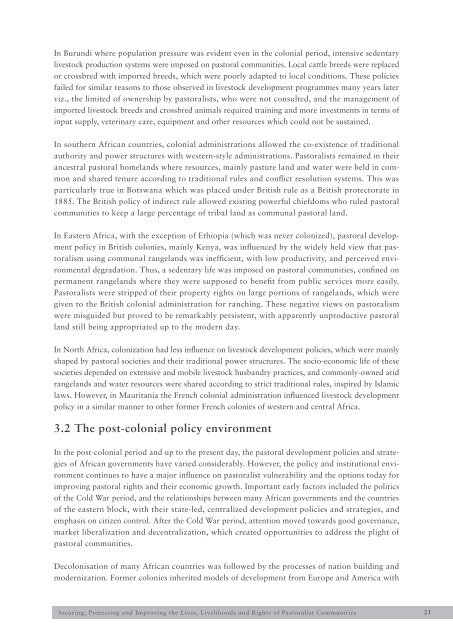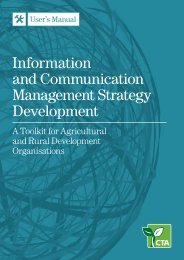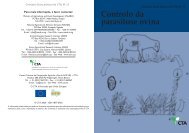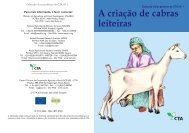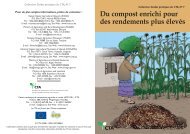Policy framework for Pastoralism in Africa
Policy framework for Pastoralism in Africa
Policy framework for Pastoralism in Africa
- No tags were found...
Create successful ePaper yourself
Turn your PDF publications into a flip-book with our unique Google optimized e-Paper software.
In Burundi where population pressure was evident even <strong>in</strong> the colonial period, <strong>in</strong>tensive sedentarylivestock production systems were imposed on pastoral communities. Local cattle breeds were replacedor crossbred with imported breeds, which were poorly adapted to local conditions. These policiesfailed <strong>for</strong> similar reasons to those observed <strong>in</strong> livestock development programmes many years laterviz., the limited of ownership by pastoralists, who were not consulted, and the management ofimported livestock breeds and crossbred animals required tra<strong>in</strong><strong>in</strong>g and more <strong>in</strong>vestments <strong>in</strong> terms of<strong>in</strong>put supply, veter<strong>in</strong>ary care, equipment and other resources which could not be susta<strong>in</strong>ed.In southern <strong>Africa</strong>n countries, colonial adm<strong>in</strong>istrations allowed the co-existence of traditionalauthority and power structures with western-style adm<strong>in</strong>istrations. Pastoralists rema<strong>in</strong>ed <strong>in</strong> theirancestral pastoral homelands where resources, ma<strong>in</strong>ly pasture land and water were held <strong>in</strong> commonand shared tenure accord<strong>in</strong>g to traditional rules and conflict resolution systems. This wasparticularly true <strong>in</strong> Botswana which was placed under British rule as a British protectorate <strong>in</strong>1885. The British policy of <strong>in</strong>direct rule allowed exist<strong>in</strong>g powerful chiefdoms who ruled pastoralcommunities to keep a large percentage of tribal land as communal pastoral land.In Eastern <strong>Africa</strong>, with the exception of Ethiopia (which was never colonized), pastoral developmentpolicy <strong>in</strong> British colonies, ma<strong>in</strong>ly Kenya, was <strong>in</strong>fluenced by the widely held view that pastoralismus<strong>in</strong>g communal rangelands was <strong>in</strong>efficient, with low productivity, and perceived environmentaldegradation. Thus, a sedentary life was imposed on pastoral communities, conf<strong>in</strong>ed onpermanent rangelands where they were supposed to benefit from public services more easily.Pastoralists were stripped of their property rights on large portions of rangelands, which weregiven to the British colonial adm<strong>in</strong>istration <strong>for</strong> ranch<strong>in</strong>g. These negative views on pastoralismwere misguided but proved to be remarkably persistent, with apparently unproductive pastoralland still be<strong>in</strong>g appropriated up to the modern day.In North <strong>Africa</strong>, colonization had less <strong>in</strong>fluence on livestock development policies, which were ma<strong>in</strong>lyshaped by pastoral societies and their traditional power structures. The socio-economic life of thesesocieties depended on extensive and mobile livestock husbandry practices, and commonly-owned aridrangelands and water resources were shared accord<strong>in</strong>g to strict traditional rules, <strong>in</strong>spired by Islamiclaws. However, <strong>in</strong> Mauritania the French colonial adm<strong>in</strong>istration <strong>in</strong>fluenced livestock developmentpolicy <strong>in</strong> a similar manner to other <strong>for</strong>mer French colonies of western and central <strong>Africa</strong>.3.2 The post-colonial policy environmentIn the post-colonial period and up to the present day, the pastoral development policies and strategiesof <strong>Africa</strong>n governments have varied considerably. However, the policy and <strong>in</strong>stitutional environmentcont<strong>in</strong>ues to have a major <strong>in</strong>fluence on pastoralist vulnerability and the options today <strong>for</strong>improv<strong>in</strong>g pastoral rights and their economic growth. Important early factors <strong>in</strong>cluded the politicsof the Cold War period, and the relationships between many <strong>Africa</strong>n governments and the countriesof the eastern block, with their state-led, centralized development policies and strategies, andemphasis on citizen control. After the Cold War period, attention moved towards good governance,market liberalization and decentralization, which created opportunities to address the plight ofpastoral communities.Decolonisation of many <strong>Africa</strong>n countries was followed by the processes of nation build<strong>in</strong>g andmodernization. Former colonies <strong>in</strong>herited models of development from Europe and America withSecur<strong>in</strong>g, Protect<strong>in</strong>g and Improv<strong>in</strong>g the Lives, Livelihoods and Rights of Pastoralist Communities21


